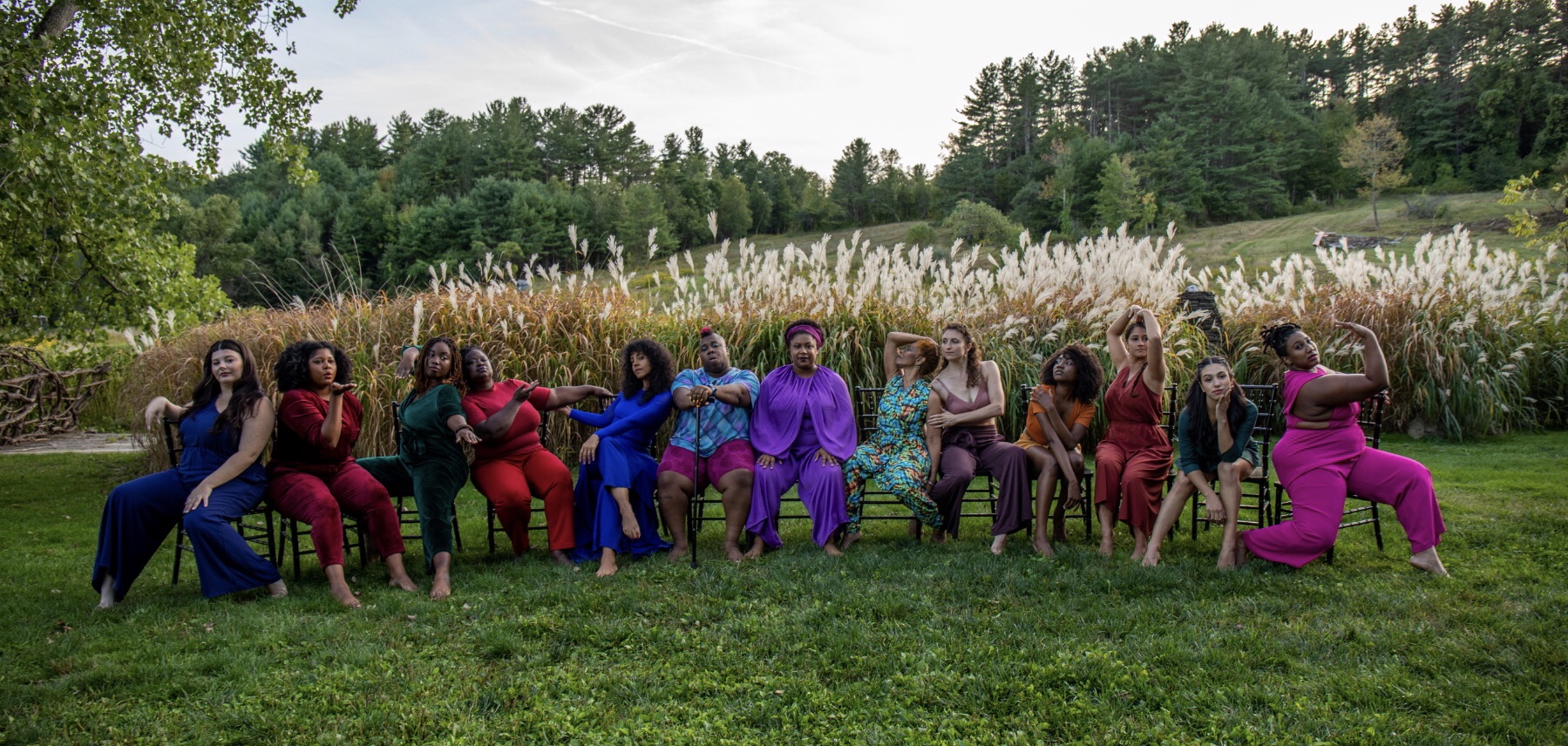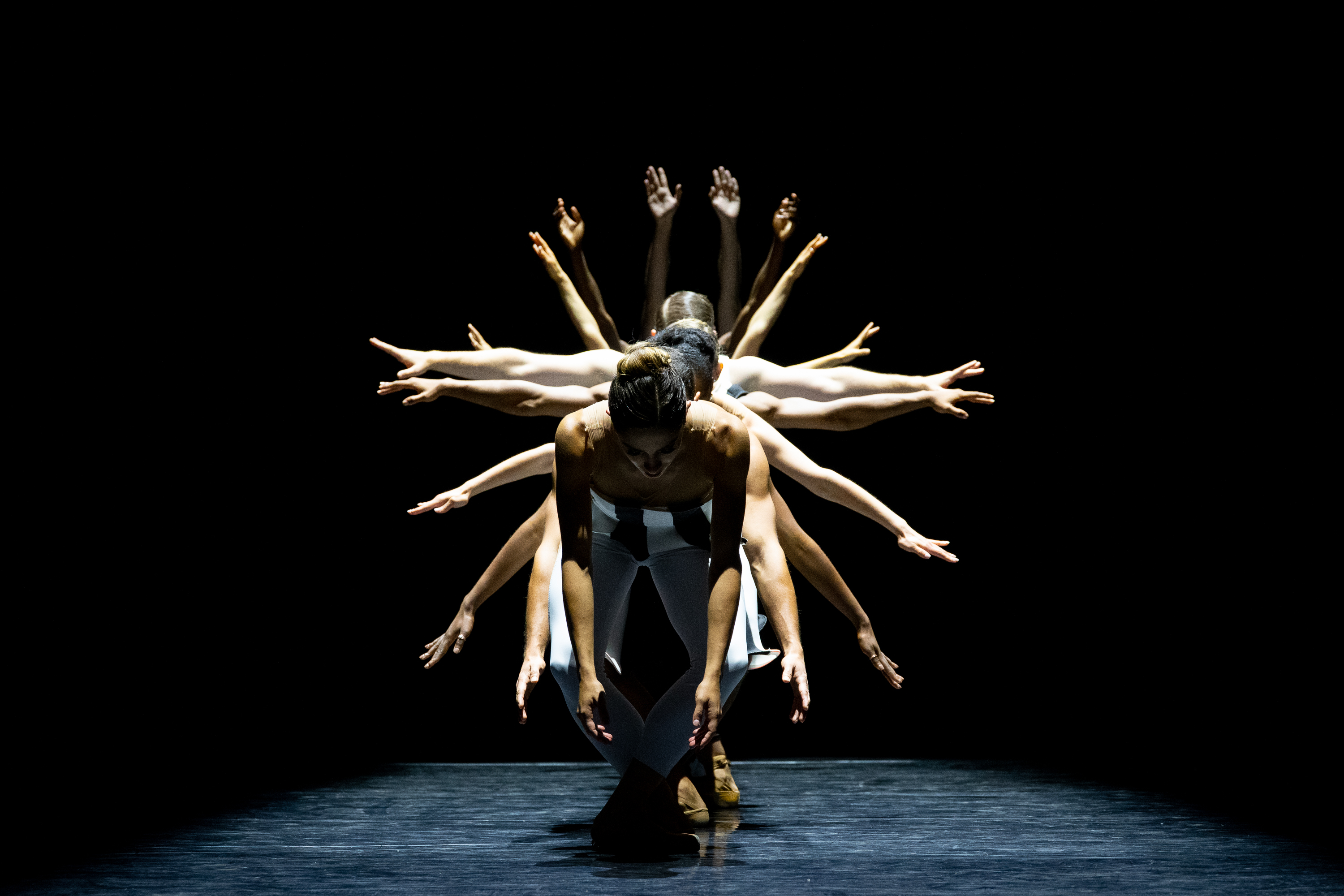When the Spirit Moves…
Alvin Ailey American Dance Theater at The Kennedy Center
Tuesday, February 6, 2024, 7:30 p.m.
By Ashayla Byrd (she/they)
(title photo credit: Revelations. Alvin Ailey American Dance Theater. All photos by: ©Paul Kolnik)
The entryway of the John F. Kennedy Center for the Performing Arts’ Opera House looks more melanated than any audience I have ever seen in their space. The vitality of audience members passes through every bright smile, set of braids, proud elder, and scented oil I experience. We Black folks, from the younger to the seasoned, were not the only bodies in the space. Of course, I noticed us first. On the whole, the eager showgoers migrating into the theater buzzed with anticipation. I, accompanied by a dear friend and dance-lover, followed suit and nestled into my seat. I opened up my notebook, added some lead to my pencil, and sat back. When the scarlet, velour curtain lifted, I was hailed by a suspicious mist.
I have been trained to be wary of what emerges from mist. Its ominous nature and evocative presence often fail to foster feelings of comfort or peace. When accompanied by lightly audible, ambient sound, I feel inclined to brace for impact. My anticipation only sharpens when a single pool of crisp, white light cascades down a black-clad triptych of male-presenting dancers in biketards. They are casually seated at a downstage corner. With their eyes affixed on an indeterminate point across an empty stage, they ultimately decide to traverse its vast expanse in tandem with one another.

While remaining connected, the trio slinks, expands, and contracts. Each sinew of each body’s movement is impacted by the others. Their arms reach and extend past themselves in search of the path forward, rigid movement suddenly broken by the undulation of a spine or a loose hip circumnavigating the available negative space. Every step is carefully calculated and virtuosic in its execution. Simply put, Alonzo King’s Following the Subtle Current Upstream begins with a journey forward. To what, I wonder? The mist bears the mystery.
Regardless of the destination, the dancers wander with a prowess and intentionality that captivates me. Waves of incoming dancers converge, flowing on and off of the stage. This calculated, sterile negotiation of space and movement is interrupted by other dancers staking their claim on the stage. Each combination of solos, duets, trios, and small group vignettes suggests an increased urgency to separate from the restrictions and machine-like existence life’s mundanity sometimes elicits. Femme dancers in combinations of canary yellow, tangelo orange, forest green, and flesh-toned mesh surprise me, sweeping the stage with a vivacity to match.
They signal a renewed sense of zest and verve, an animation that is skillfully paired with the initial sounds of rain and thunder that transition into the voices and instrumental soundscapes of Zakir Hussain, Miguel Frasconi, and Miriam Makeba. Hailed by King as “a piece about how to return to joy,” Following the Subtle Current Upstream exemplifies the human spirit’s need for release, surrender, and unbridled expressions of pleasure and passion. A single dancer closes the work with a sparkling, energetic solo as a large lighting fixture descends from above. I was overtaken by catharsis when the solo ended and the lights went down, thinking, “I know they must be tired!”
After the first intermission of the evening, no mist met me–only blue hues. The tranquility created by the opening of Ronald K. Brown’s Dancing Spirit illustrates a different sense of release, one that can be found in a steady, continued progression forward. A single dancer in white gently carves the space as a soft, repetitive, piano-like melody plays. He emerges from the furthest upstage corner and squarely faces the downstage while dancing, and the rest of the large ensemble moves in step behind him, one by one, while executing the same movement phrase until they exit the stage on the opposite side. Each dressed in their own combinations of white and varying blues, the dancers glide across the stage with a care and synchronicity that is both elegant and meditative. Dancing Spirit honors the unparalleled legacy of Alvin Ailey American Dance Theatre’s Artistic Director Emerita, the incomparable Judith Jamison, a legacy that was built by Jamison’s dignity, grace, and consistent commitment to the company’s vision.

Brown’s celebration of Jamison tastefully fuses the “clean” lines and shape-driven nature of modern dance with the cyclical, winding aesthetics of African diasporic dance forms. Within the same phrases, a fully extended, turned out leg folds in on itself, driven by circular movement initiation from the hip. Crouched forward, small groupings of dancers roll their shoulders and spines in step with the music’s downbeat, steps punctuating the rhythm that the music offers them. At certain musical breaks, the dancers drop down even further, bending their spread legs, grounding themselves, and rolling their hips in response. The full mobility and fluidity of their hips and spines, in addition to the sheer strength and agility shown in their extensions, footwork, and balances, have become characteristic of Ailey dancers.
The music, movement, and lighting flow seamlessly together like water, and the synergy seems to be confirmed by an immense projection of the moon that takes over the stage towards Dancing Spirit’s conclusion. The rustic sounds of Duke Ellington and Wynton Marsalis and the cool, rich swaths of royal and cerulean blue lights all coalesce to create a truly ethereal, spiritual environment. The intricate sounds of Radiohead and War create a complexity in the soundscore that further deepens the introspection that the solo and duet moments bring forward. The ensemble is both grounded and driven by the pulse of the music they move to, fully engulfed in the spirit of the dance, no pun intended. The collective’s energy is enlivened and uplifted by their connection to one another. The authenticity of their expressions exemplify the liberation of the spirit, a testament to Judith Jamison’s legacy. As the ensemble moves together, her legacy expands and the vision of the Alvin Ailey American Dance Theatre is carried forward.

Although the entire audience knew what was coming, we erupt with thunderous applause at the sight of the dancers’ flesh-toned costumes, eyes beaming upwards at the warm spotlight hovering above them as “I’ve been ‘buked, I’ve been scorned…” billows through the theater. The dancers’ arms swell out and curve downward; the closer to the front of the stage they are, the further down they sink. The weight of their movement, and the control with which they execute it, are palpable. The simplicity and striking quality of this opener sets the tone for the dynamic works within Revelations that follow, like “Fix Me Jesus”, “Wade in the Water”, “Sinner Man”, and “Rocka My Soul in the Bosom of Abraham.” The world that Ailey created in 1960, presented by and for Black people, still permeates throughout the audience in 2024. Universal experiences like joy and grief, can be felt by all, but its translation to Black bodies highlights the cultural and historical context that non-Black audiences may not have in advance. It would be ideal if folks had this awareness anyway, but we know what assumptions do.
When speaking of legacy and liberation of the spirit, the inclusion of Revelations, a seminal work of Alvin Ailey and the company’s repertoire, was completely unsurprising. And yet, each production is just as arresting as the one preceding it. This work celebrates Black spirit and exemplifies its impenetrability. Created at a time when such celebrations on the concert stage were few and very far between, Revelations remains pivotal to the dance canon. We are further now from the spirituals, church fans, and fitted suits of the 1900s than we were at the time of the work’s inception. Unfortunately, the deep sorrow and grief explored in this work, namely brought about by racial trauma and violence, still ring true. Those sorrows have simply mutated over time.
Through it all, Black joy, our joy, my joy–it remains. It insists. It resists. It transforms. Revelations entered the stage as one of concert dance’s many introductions to the depth and complexity of Blackness. In our current times, the field needs this reminder. Revelations continues to be a dance scripture, a sacred movement text held within the container of the Alvin Ailey American Dance Theater. I am eager to read the verses to come, and I will be sure to share my musings then, too.
_____________
Ashayla Byrd (she/they) (@abyrdnyca) is a DC-based dance artist and writer who is dedicated to amplifying the voices of BIPOC, LGBTQIA+ folks. Originally from Virginia Beach, Ashayla is eager to explore the richness of DC’s dance and writing communities!






Leave a Reply